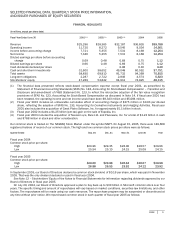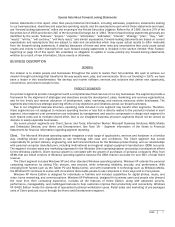Microsoft 2005 Annual Report Download - page 11
Download and view the complete annual report
Please find page 11 of the 2005 Microsoft annual report below. You can navigate through the pages in the report by either clicking on the pages listed below, or by using the keyword search tool below to find specific information within the annual report.
BUSINESS DESCRIPTION (CONTINUED)
PAGE 10
The segment generates revenue primarily from advertisers on MSN, from consumers and partners, through subscriptions
and transactions, and from subscribers to MSN narrowband Internet access. According to studies performed by Nielsen Net
Ratings and comScore Media Metrix, MSN Web sites are among the most popular on the Internet, visited by more than 420
million unique users every month. MSN Hotmail is one of the world’s largest e-mail services with more than 205 million
accounts, and MSN Messenger is one of the world’s largest instant-messaging services with more than 175 million accounts.
MSN also provides a variety of paid solutions including MSN Internet Access and MSN Premium Web Services.
Mobile and Embedded Devices. The Mobile and Embedded Devices segment is responsible for the development and
marketing of products that extend the advantages of the Windows platform to many types of devices, including mobile devices
that incorporate voice, personal information management, and media capabilities, and a wide variety of other devices designed
to improve people’s personal and work lives. Microsoft’s vision for mobile devices is rooted in the convergence of the computing
and wireless industries, which brings new opportunities to improve communication and information access for customers. We
see software as a key differentiator in making smart devices and wireless data services valuable to customers through rich
experiences such as mobile messaging, location-based services, media, and speech recognition. We are working closely with
mobile operators, and hardware and software partners to accelerate the development and availability of smart devices and
services, and to provide a broad range of choices for customers. The segment is also responsible for managing our company-
wide sales and customer relations with mobile device manufacturers, and with host and network equipment and service
providers, including telecommunications and cable and wireless companies.
The segment consists of the Windows Mobile software platform, the Windows Embedded device operating system family,
MapPoint, and Windows Automotive. The Windows Mobile software platform provides a familiar and integrated customer
experience that is the basis for specific devices like the Pocket PC, Pocket PC Phone Edition, Smartphone, and Portable Media
Center. Windows Embedded, including Windows CE, Windows XP Embedded, and Windows XP Embedded for Point of Service, is
a family of embedded device software platforms used in non-PC computing devices. Windows Embedded software is used
widely in advanced consumer electronics devices, including digital televisions, Internet Protocol (IP)-based set top boxes,
network gateways, and portable media players, and in enterprise devices such as industrial controllers, retail point-of-sale
systems, and voice-over-IP phones. The MapPoint family of location-enabled products and services includes the MapPoint Web
Service, a hosted programmable XML Web service that allows developers to integrate location intelligence in applications,
business processes and Web sites, and business and consumer oriented mapping CD-ROM products. Windows Automotive is an
automotive-grade software platform that provides developers with the building blocks to quickly and reliably create a broad
range of advanced telematics solutions for vehicles. In fiscal year 2006, Mobile and Embedded Devices expects to release
added functionality to the Windows Mobile 5.0 platform through the Microsoft Enterprise Feature Pack and the Exchange
Service Pack 2.
Effective July 1, 2005, functions related to MapPoint in Mobile and Embedded Devices have been moved to MSN. This
reorganization will result in a corresponding change to the Mobile and Embedded Devices and MSN reported results.
Home and Entertainment. The Home and Entertainment segment is responsible for development, production, and marketing
for the Xbox video game system, including hardware, third-party games, games published under the Microsoft label, Xbox and
Xbox Live operations, marketing, research, and sales and support. The segment also leads the development efforts of our Home
Products Division (HPD) product lines. In addition, it carries out all retail sales and marketing for Microsoft Office (for which it
receives an inter-segment commission), the Windows operating systems, Xbox, PC games, and HPD products. It is also
responsible for the development, sales, and deployment of Microsoft’s TV platform products for the interactive television
industry.
Microsoft Xbox, released in fiscal year 2002, is a video game console system that delivers high-quality graphics and audio
experiences. Xbox 360, unveiled in May 2005, is our next-generation video game and entertainment system that we expect to
be available in the first half of fiscal year 2006 in Europe, Japan and North America. In addition to Xbox, we offer several types
of entertainment products, including PC software games, online games, and console games. HPD includes Microsoft’s line of
consumer software and hardware products, such as the Encarta line of learning products and services, application software for
Macintosh computers, the Works productivity suite, and Microsoft PC hardware products such as mice, keyboards, and game
controllers. The MSTV group develops the MSTV Foundation Edition and Internet Protocol TV (IPTV) products.
OPERATIONS
To serve the needs of customers around the world and to improve the quality and usability of products in international markets,
we “localize” many of our products to reflect local languages and conventions. Localizing a product may require modifying the
user interface, altering dialog boxes, and translating text. Our research and development facilities are located primarily in
























